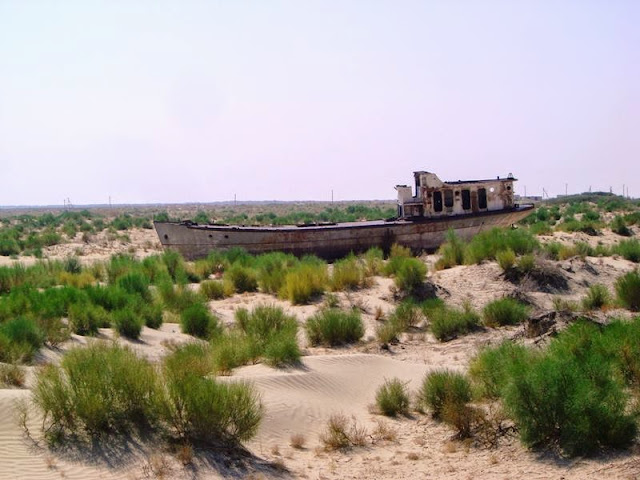In Uzbekistan, an eerie ship
graveyard filled with hauntingly beautiful shipwrecks beckons, is literally a
ghost town in the middle of the desert. Moynaq ship Graveyard — Mo‘ynoq also
spelled as Muynak and Moynaq, is a city in northern Karakalpakstan in western
Uzbekistan. It was formerly a sea port, now home to only a few thousand residents
at most. Mo‘ynoq's population has been abating precipitously since the 1980s
due to the recession of the Aral Sea. Because in the last 30 years Moynaq was
one of two biggest Soviet fishing harbors at the Aral Sea. As the scarce few
travelers who have traversed this most barren and isolated of landscapes will
tell you, it’s perhaps the last place on earth you’d expect to find a flotilla
of abandoned ships. Except this isn’t a mirage you’ve reached the Graveyard
Ships of Mo’ynaq, a surreal collection of rusting fishing vessels in
Uzbekistan, stranded nearly 100 miles from the nearest shoreline.
The Aral Sea has been gradually declining
since the 1960s, as the waters of the two rivers feeding it, the Amu Darya and
Syr Darya, were aimed at irrigating agricultural areas. Actually formerly one
of the four largest lakes in the world with an area of 68,000 km2 or 26,300 sq
mi. Aral Sea has been steadily shrinking since in 1960s after the rivers that
fed it were diverted by Soviet irrigation projects. In 2007, it had dropped to 10% of its
original size, splitting into four lakes! the North Aral Sea, the eastern and
western basins of the once far larger South Aral Sea, and one smaller lake
between the North and South Aral Seas. Though, in 2009, the southeastern lake
had disappeared and the southwestern lake had retreated to a thin strip at the
extreme west of the former southern sea.
Moreover, the maximum depth of
the North Aral Sea is 42 meter or 138 ft in 2008.The lessening of the Aral Sea
has been called "one of the planet's worst environmental disasters".
The region's once-prosperous fishing industry has been basically destroyed,
bringing unemployment and economic adversity. The Aral Sea region was also
heavily polluted, with following serious public health problems. The retreat of
the sea has reportedly also caused local climate change, with summers becoming
hotter and drier, and winters colder and longer.In an ongoing effort in
Kazakhstan to save and replenish the North Aral Sea, a dam project was
completed in 2005; in 2008, the water level in this lake had risen by 12 m or
39 ft compared to 2003. Salinity has dropped, and fish are again found in
sufficient numbers for some fishing to be viable.
The Aral Sea watershed covers
Uzbekistan and parts of Tajikistan, Turkmenistan, Kyrgyzstan and Kazakhstan. Nowadays
Mo‘ynoq's is a major tourist attractions are the armada of rusting hulks that
once made up the proud fishing fleet during the Soviet era. Even a one-room
museum devoted to Mo‘ynoq's heritage as a center of the fishing industry. Though,
poisonous dust storms kicked up by strong winds across the dried and polluted
seabed give rise to a multitude of chronic and acute illnesses between the few
residents who have selected to remain, most of them ethnic Karakalpaks, and
weather unmoderated by the sea now buffets the town with hotter-than-normal
summers and colder-than-normal winters. Let's take a closer look and see how
these ships came to be stranded in the middle of the desert.





























































